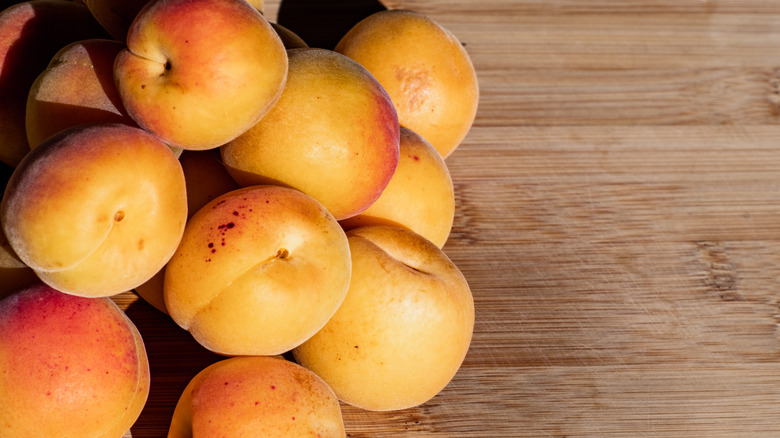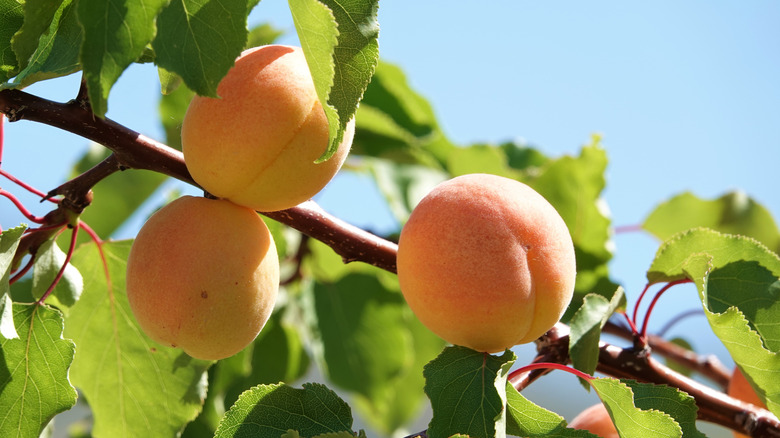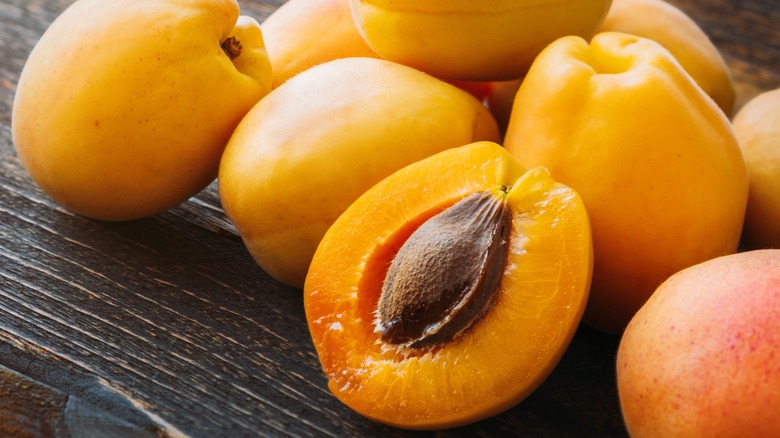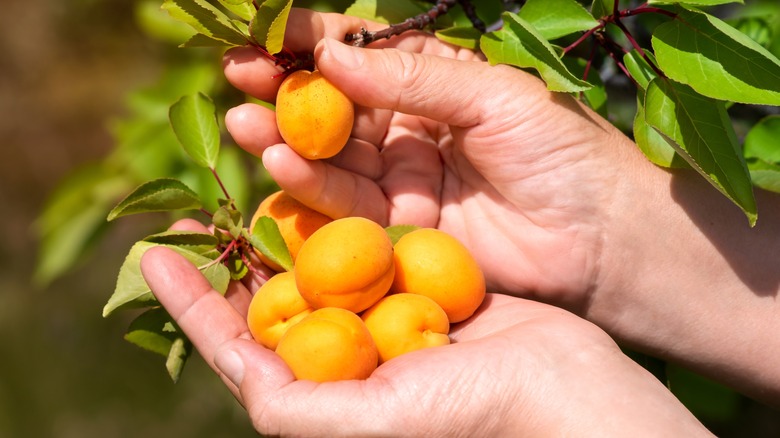The Endangered Apricot Variety That's Often Sold Dried
The Blenheim apricot (prunus armeniaca) is a unique, special fruit that at one time was highly favored in the United States and particularly California. Today, they are grown in small concentrations in the United States and Europe. While they aren't as widely consumed as they used to be, those in the know still regard them as a cut above many comparable stone fruits.
In California, there are a handful of orchards that specialize in these small stone fruits. But because of shipping difficulties outside of the golden state, it's much more likely that you would have access to dried Blenheim apricots instead of fresh ones. Even then, it's unlikely you'll find them in supermarket chains — your best bet is to order dried ones online.
Blenheim apricots are delicious and highly versatile in the kitchen, but a myriad of factors have combined to contribute to Blenheim apricots nearly vanishing from the United States completely.
What are Blenheim apricots?
Blenheim apricots, a member of the Rosaceae family, are a variety of apricots that are rosy-orange and a little bigger than a ping-pong ball. Oddly, their exact origins are uncertain. Apricots, in general, are native to Asia. Many say that the first time Blenheim apricots specifically achieved notoriety was in the Luxembourg gardens of Paris in the early 1800s. Shortly after, it appeared in England, being grown in the gardens of the Blenheim Palace. By the end of the 1800s, Spanish missionaries had brought this apricot variety to California in the United States.
During World War I, an increase in demand for dried fruit drove the cultivation of Blenheim apricots to expand dramatically. By the end of the 1920s, California's Santa Clara Valley (part of what's known widely as "Silicon Valley" due to the area's tech boom) was covered in Blenheim apricot orchards.
For a brief period, Blenheim apricots were a widely appreciated and beloved fruit. However, their status as highly desired commodities wouldn't last for very long.
Why are Blenheim apricots endangered?
After booming during World War I, the Blenheim apricot market faced several challenges. First, this apricot variety is highly perishable, susceptible to disease, and does not travel well. As the fruit and vegetable market became increasingly globalized, it became easier and cheaper for vendors in the United States to sell imported apricots than California-sourced Blenheim apricots.
Another big obstacle facing Blenheim apricots was the rapid urbanization of California and Santa Clara Valley in particular. These pressures worked together to condense the cultivation of Blenheim apricots to just a handful of orchards in the country, most of which are in California. In 1988, California produced 32,000 tons of Blenheim apricots. By 2008, that number had dropped to just 4,000 tons.
Because of their vanishing status, the Slow Food Foundation for Biodiversity has added the Blenheim apricot to their "Ark of Taste," a collection of foods that are in danger of disappearing from our tables altogether. Increasing awareness of this fruit variety can save it from vanishing entirely.
What do Blenheim apricots taste like?
Blenheim apricots are on the smaller side and are generally orange and rosy in color, like a beautiful sunset. They ripen from the inside out, so you may often see Blenheim apricots retaining the appearance of green shoulders even when they are ready to eat.
In addition to an appetizing appearance, ripe Blenheim apricots give off a delightful aroma that many characterize as sweet and floral. Taste-wise, some have compared the Blenheim apricot to honey — they are smooth and balanced. Blenheim apricots are known for having a perfect balance between sweet and tangy, creating a split of sugar and acid that makes them perfect for desserts, salads, and eating straight off the tree. Like many other varieties of apricot, the skin features a light fuzz, and the interior texture is firm but juicy.
Dried Blenheim apricots have a chewy texture, and the sweetness of the fruit is emphasized, making them a healthy but delicious snack.
How to cook with Blenheim apricots
Because Blenheim apricots are the perfect balance of sweet and tangy, they go well in several dishes and can be used for any meal. In most recipes, you'll find that very little has to be done to prepare the apricots for cooking — wash and pit the apricots, which you can do easily with a paring knife. In most cases, peeling the skin is not necessary.
If you live in California or somewhere with access to fresh Blenheim apricots, you may find that the best preparation option is to slice and add to a fresh green salad. Desserts and cocktails are also good candidates for Blenheim apricots. Though it may seem surprising, the acid balance of the apricots also makes them a great addition to savory foods like an apricot-praline panini. Or substitute Blenheim apricots into any recipe that calls for your favorite stone fruit, like grilled flatbreads or a fall lattice pie.
And don't worry — if you live outside of California and don't have access to fresh Blenheim apricots, there are plenty of options to cook with dried ones, like an apricot-orange baked oatmeal or Moroccan couscous.
Where to buy Blenheim apricots
Blenheim apricots have a very short harvest season (sometimes as few as only ten days long) and bruise very easily. These and other factors, such as perishability and unpredictable yields, make Blenheim apricots difficult to ship. Their specific growing needs make California the best place in the U.S. to grow Blenheim apricots, and a few orchards in the Santa Clara Valley still cultivate them.
Therefore, the best place to get fresh Blenheim apricots is in California. Even then, you're more likely to find these boutique fruits at a farm stand or farmer's market than at a big grocery store. Fortunately, there are more options for buying Blenheim apricots dried. Some orchards like B&R Farms will even ship the dried fruit and other Blenheim apricot products straight to your door.
In California, some restaurants will add dishes with Blenheim apricots to their menus during their short harvest season, which tends to be late spring to early summer. If you're in the Bay Area in June, keep an eye out for these delectable fruits.
Nutritional information about Blenheim apricots
Blenheim apricots are a nutritious snack that is easy to add to your diet. One of the main dietary benefits of eating fruits like this is the addition of fiber, which helps to promote healthy digestion and is important for gut health. Two apricots can provide you with 1.5 grams of fiber. Make sure you eat apricots with the skin because that's where much of this fiber resides.
Apricots are also rich in vitamins. Two apricots contain 8% of your daily value of vitamins A and C and 4% of vitamin E and potassium. According to Healthline, these vitamins may benefit skin and eye health. Additionally, apricots are rich in antioxidants, which help prevent oxidative stress, a phenomenon linked to heart disease. Whether you prefer raw apricots or cooked in your favorite dish, eating just two a day is not just a delicious addition to your diet but a healthy one.






